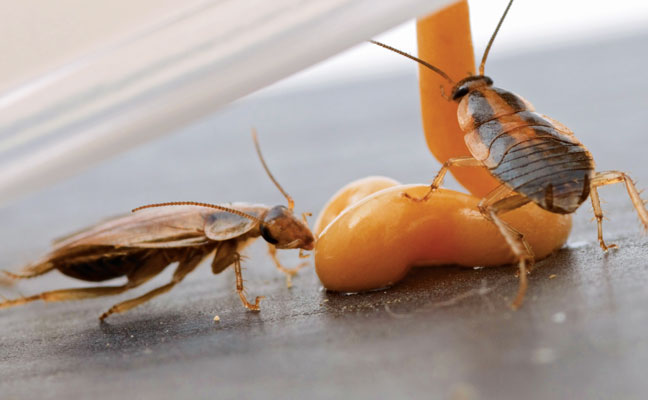- Manage resistance by always using more than one class of insecticide.
- Rotate among classes of insecticides that are subject to resistance.

German cockroaches can become finicky beasts at times, but these cockroaches are indicating that this bait will do nicely.
PHOTO: MARK SHEPERDIGIAN, BCE
One of the major reasons why German cockroaches (Blattella germanica) are difficult to control is resistance to the pesticides we use. They can develop metabolic resistance to contact insecticides — and a behavioral resistance to baits, known as bait aversion.
The process of managing resistance involves two strategies: rotating active ingredients that are subject to resistance and using multiple formulations and methods.
The most common strategy is to rotate from pyrethroids to actives with a different mode of action. Other pyrethroids may have different actives, but they work with the same mode of action. If you aren’t sure which classes you can choose from, you can get help from a number of resources, such as the Insecticide Resistance Action Committee. While you can choose sprayables or crack-and-crevice products with actives in different classes, for example, it is important to incorporate different formulations into your strategy.
Why resistance occurs
Resistance builds when naturally resistant individuals survive and reproduce with other naturally resistant individuals. The best way to avoid resistance is to eliminate the population. Many accounts have chronic cockroach problems, however, and distinguishing between a surviving population and a reintroduction of cockroaches can be difficult. For this reason, it is wise not to rely on the same product month after month — let alone year after year.
Instead, try an integrated approach, with a combination of actives. Adding inorganic dusts such as boric acid and amorphous silica is a solid addition to any program, whether it’s bait or contact insecticides. Both the borates and the desiccant dusts have unique modes of action and, to date, have not shown any resistance. Keep in mind, though, that desiccant dusts are repellent and boric acid-based products are nonrepellent.
In addition to dusts, insect growth regulators (IGRs) are unique in their mode of action, and work well in both baiting and contact insecticide strategies. By incorporating multiple methods in your control efforts, you never rely on a single mode of action.
As always, be sure to use insect monitors to focus your efforts and to indicate when cockroach activity has ceased. Also, start new accounts with an intensive treatment that includes a vacuum cleaner to physically remove as many cockroaches as possible.
Last but not least, stay vigilant for accounts that have lingering populations, as this is an indication that something is awry.
You can reach Mark Sheperdigian, BCE, vice president of technical services, Rose Pest Solutions, Troy, Mich., at shep@rosepest.com.
Leave A Comment